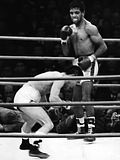Lionel Rose's career embodied the stuff legends are made of. In a boxing career begun in a makeshift ring in a poverty stricken aboriginal settlement, Rose developed a crushing punch that helped him become the first Australian aborigine to win a world championship title, and the second Australian to take home a world title in boxing. His win catapulted him to fame in Australia. His lifetime career of 53 fights with only 11 losses made him a legend in the world of boxing.
Followed Father into the Ring
Lionel Rose was born June 21, 1948, and raised in Jackson's Track, a poor aboriginal settlement 50 miles south of Melbourne. The oldest of nine children in an aboriginal family, Rose was on the wrong side of a society divided by racism, mistrust, and economic disparity. Since 1770, when white settlers first arrived in Australia, the aborigines—Australia's dark-skinned native people—have suffered a fate similar to that of Native Americans in the United States. By the early 1900s, entire aboriginal communities had disappeared. Up until the 1970s, the Australian government imposed a program of social adaptation that consisted in removing aboriginal children from their families and rearing them in state-run boarding schools. Though Australian policy has since adopted aboriginal rights legislation and aborigines have officially gained equal status as Australian citizens, racism has continued.
As a child, Rose escaped such racism through boxing. Rose's father, an amateur boxer, inspired Rose to don his first pair of boxing gloves at the age of 14. The pair trained in a ring made of chicken wire. Rose and his siblings also became avid fans of tent matches—popular boxing bouts that traveled the country much the way a circus might. However, it was at a ring match in Melbourne that Rose found his inspiration in another aboriginal boxer. "I'd seen plenty of tent fights when I was younger, but the great George Bracken was the first boxer I saw in the ring," Rose told the web site Vibe Australia. "His great fighting style and speed really made me take an even bigger interest in boxing than before."
Rose began his amateur boxing career under the guidance of trainer Frank Oakes. He later married Oakes's daughter Jenny. Rose won his first big fight in 1963, the day after the death of his father. By the end of that year, Rose had won Australia's national amateur flyweight title. Flyweight is one of the lowest weight classifications in boxing, with an upper limit of 112 pounds. In 1964 Rose narrowly missed being selected for the Australian Olympic team. By that time, Rose knew he wanted to make a career of boxing and decided to go professional.
Rose Through the Ranks of Australian Boxing
In 1964 Rose began his professional training at Jack Rennie's Melbourne gym. Rennie, a legendary figure in Australian boxing, worked Rose hard, often pairing him with Mick Croucher, a more experienced boxer 20 pounds heavier than Rose. Croucher recalled to the World Boxing Foundation Web site: "Champions are born, not made, and [Rose] had enormous natural ability. Some people work hard in training and are very dedicated but to be a champion in any sport a person must be born with a natural gift and Lionel was fortunate enough to have that." Under Rennie, Rose moved to the bantamweight division, with a weight limit of 118 pounds. He also developed what The Age described as "[an] easy style married to a tooth-shaking straight left to the clenched jaws of all who came against him."
In September of 1964, Rose won his first professional bout in eight rounds. He won his next four fights in a row. In all of 1965, Rose lost only one fight. Between January and October of 1966, Rose won six of seven matches, qualifying to compete for Australia's bantamweight title. On October 28, 1966, Rose beat the reigning champion, Noel Kunde, in a 15 round decision to win the title. Rose went on to win his next nine matches including a 13 round challenge to his title in December of 1967. That fight made Rose famous in Australia as his challenger, Rocky Gatellari, was expected to win. Yet, that fame was nothing compared to what was about to come.
By 1968, Rose had a fight record of 29 wins, two losses. He was the two-time Australian bantamweight champion, and had developed quite a following in the boxing world. Boxing promoters at the international level took notice and offered Rose a chance to fight then bantamweight world champion, Masahiko "Fighting" Harada, at a title match in Tokyo. The Japanese fighter was already a legend in the ring, having success-fully defended his world title five times. Rose was eager to take him on. Rennie was not so sure. According to the World Boxing Foundation Web site Rennie thought Rose, then barely 19 years old, "wasn't yet ready for a World Title shot." Nonetheless, Rose accepted the challenge.
Won World Bantamweight Championship
Rose arrived in Tokyo six weeks prior to the fight to train extensively and assimilate to Japanese culture. Despite his preparations, no one considered him a threat to Harada's title. Boxing scholar Jim Amato noted on the Inside Boxing web site, "When this Australian entered the ring to face Harada he was a prohibitive underdog. Very few gave him a legitimate chance." Rose ignored the naysayers and entered the ring with confidence. An estimated 30 million Australians, tuning in by radio and television, entered with optimism.
Rose started the fight by holding back, a stance which caught Harada off-guard. "I expected Rose to come in and attack first but he didn't. So I started to take the initiative myself. That is where I made a mistake," Harada told The Age. After the third round, despite injuring his hand, Rose told Rennie, "Don't worry about me; this bloke can't punch," noted The Age. That seemed true throughout much of the fight as Harada unleashed a volley of punches that Rose either ducked or absorbed without much notice. Meanwhile, Rose landed several stunning blows to the champ. "By the end of the flight the desperate champion was chasing Rose round the ring," wrote The Age. After 15 rounds, Rose became the new World Bantamweight Title. The disappointed Japanese crowd was stunned, but gave Rose a respectful ovation as he struggled to hold aloft the massive title trophy. Rennie proudly told The Age, "[Rose] was a boy doing a man's work, and he did it well. He was in a strange country, among a strange crowd, and he did not let this worry him."
Awards: Australian Amateur Flyweight Champion, 1963; Australian Bantamweight Champion, 1966, World Bantamweight Champion, 1968; Australian of the Year, 1968; Deadly Awards, Lifetime Achievement in Sport, 2005.
Addresses: Home—Drouin, Victoria, Australia.
When Rose returned to Melbourne, he was met by an estimated quarter-million people lining the streets to welcome him home. "It was simply unbelievable," Rose told Vibe Australia. "To fulfill my ultimate dream and then be met by so many people was amazing. My picture was all over the newspapers and it made me realize how much it meant to everyone." Later that year he was named Australian of the Year, the first aborigine to receive such an honor. Rose had not only become an Australian hero, he had also become an aboriginal icon. "To see the way that my people looked at me and to know that I made a difference to them was an honor," he told Vibe Australia. Rose refused to get involved in political issues, instead helping aborigines at a grassroots level, often with children. One example occurred in 1999 when Rose gave his championship belt to an aboriginal child that had been set on fire in a racially-motivated attack.


 Thanks:
Thanks:  Likes:
Likes:  Dislikes:
Dislikes: 

 Reply With Quote
Reply With Quote











Bookmarks